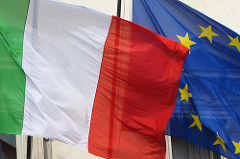Italy Drafts Guidelines for National Hydrogen Strategy
MILAN (Reuters) - Italy has set out guidelines for a national hydrogen strategy to help decarbonize the economy as it phases out coal and boosts renewable energy production to meet long-term climate targets.

In a draft document called National Hydrogen Strategy Preliminary Guidelines, seen by Reuters, the Industry Ministry said it was targeting investments in the sector of around 10 billion euros ($12 billion) to 2030, with half of the amount coming from European funds and private investments.
The ministry document, which said the plans could create more than 200,000 jobs and generate up to 27 billion euros for Italy's gross domestic product, said hydrogen could be used in transport, heavy industry and natural gas pipelines.
Italian gas group Snam has been experimenting with a 10% mix of hydrogen in part of its natural gas network, while utility Enel and energy major Eni both have hydrogen plans. Experts anticipate that a broader use of hydrogen would rely heavily on existing gas pipelines, and Snam has previously said that about 70% of its natural gas grid is already made up of is "hydrogen-ready" pipes.
To help boost production of "green" hydrogen, about 5 gigawatts of electrolysis capacity to extract the gas from water would be introduced over the period, the document said.
Electrolysis can be a carbon-free process if the power used is generated from renewables. Hydrogen is now mostly produced from fossil fuels or other carbon emitting processes, as electrolysis is too expensive due to the amount of power needed.
By 2030 hydrogen could make up 2% of Italy's final energy demand and help eliminate up to 8 million tonnes of CO2, the document said. As the industry scales up and costs fall, this could reach up to 20% by 2050, it said.
The document, when published, will become a basis for consultation before a final hydrogen strategy is approved, possibly early next year. It follows an earlier study by Snam and consultancy The European House-Ambrosetti, which concluded that Italy could become a clean energy hub for Europe by piping green hydrogen produced in North Africa from solar power at 10-15% less than it costs to produce locally.
Brussels mapped out its plans this year to promote hydrogen as it strives for net zero emissions by 2050. France, Germany, and Spain have already set out their own targets.
Hydrogen today is too expensive for widespread use but as costs fall governments round the world see it as a replacement for fossil fuel in areas where electrification is not an easy solution.
The ministry document, which said the plans could create more than 200,000 jobs and generate up to 27 billion euros for Italy's gross domestic product, said hydrogen could be used in transport, heavy industry and natural gas pipelines.
P&GJ staff contributed to this report.
Related News
Related News

- Keystone Oil Pipeline Resumes Operations After Temporary Shutdown
- Biden Administration Buys Oil for Emergency Reserve Above Target Price
- Freeport LNG Plant Runs Near Zero Consumption for Fifth Day
- Enbridge to Invest $500 Million in Pipeline Assets, Including Expansion of 850-Mile Gray Oak Pipeline
- Williams Delays Louisiana Pipeline Project Amid Dispute with Competitor Energy Transfer
- Evacuation Technologies to Reduce Methane Releases During Pigging
- Editor’s Notebook: Nord Stream’s $20 Billion Question
- Enbridge Receives Approval to Begin Service on Louisiana Venice Gas Pipeline Project
- Russian LNG Unfazed By U.S. Sanctions
- Biden Administration Buys Oil for Emergency Reserve Above Target Price




Comments